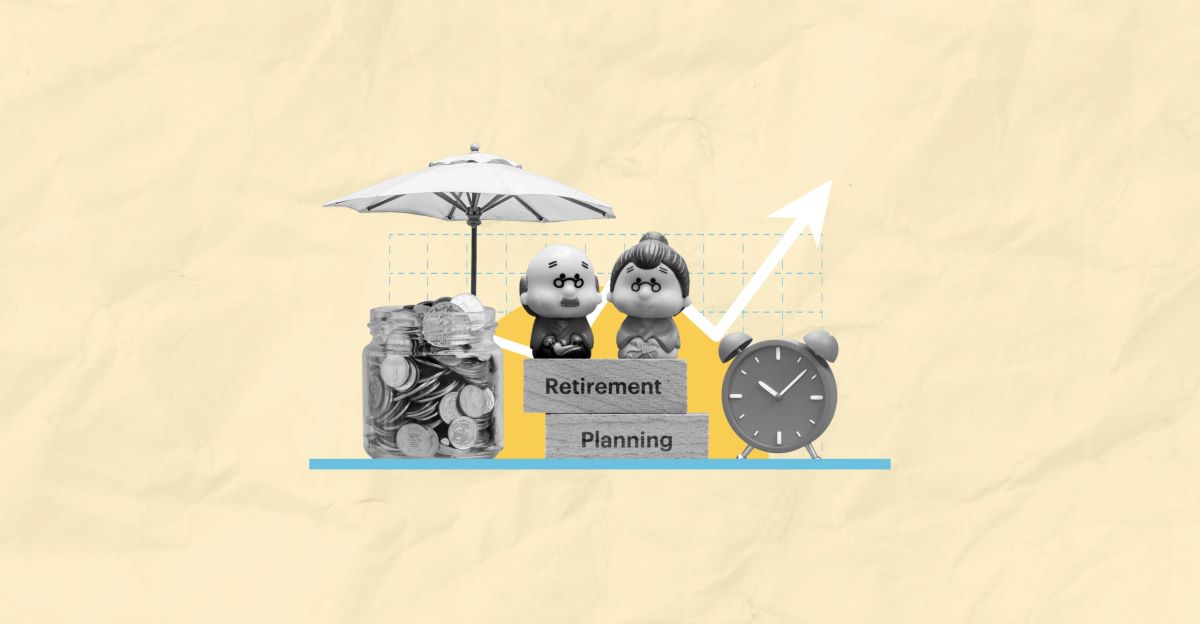Home>Finance>What Are The First Steps Of Retirement Planning


Finance
What Are The First Steps Of Retirement Planning
Published: January 21, 2024
Explore the essential first steps of retirement planning, including financial strategies and tips to secure your future. Gain control over your finances and prepare for a fulfilling retirement.
(Many of the links in this article redirect to a specific reviewed product. Your purchase of these products through affiliate links helps to generate commission for LiveWell, at no extra cost. Learn more)
Table of Contents
- Introduction
- Assessing Your Financial Situation
- Setting Retirement Goals
- Budgeting and Saving
- Understanding Retirement Accounts
- Evaluating Social Security Benefits
- Consideration of Health Care Costs
- Evaluating Long-Term Care Options
- Estate Planning and Legacy Goals
- Adjusting and Monitoring Your Retirement Plan
- Conclusion
Introduction
Retirement planning is a crucial step towards securing your financial future and enjoying a comfortable lifestyle in your golden years. It involves careful consideration of your current financial situation, setting realistic retirement goals, budgeting and saving, understanding retirement accounts, evaluating social security benefits, planning for healthcare costs, exploring long-term care options, and creating an estate plan. With proper planning and execution, you can take control of your financial destiny and ensure a financially stable retirement.
As daunting as all these steps may seem, with a bit of knowledge and guidance, you can navigate through the intricacies of retirement planning. This article will provide you with a comprehensive overview of the first steps you need to take when embarking on your retirement planning journey.
Before diving into the details, it’s important to understand that retirement planning is not a one-size-fits-all approach. Each individual’s financial situation and retirement goals are unique, so it’s crucial to tailor your plan to suit your specific needs and circumstances.
Whether you are just beginning your career or nearing retirement age, it’s never too early or too late to start planning for your retirement. The key is to take control of your finances, set achievable goals, and make informed decisions that will set you up for a secure financial future.
Assessing Your Financial Situation
The first step in retirement planning is to assess your current financial situation. This involves taking a close look at your income, expenses, assets, and liabilities. By understanding your financial standing, you can determine how much you need to save for a comfortable retirement.
Start by calculating your net worth, which is the difference between your assets (such as savings, investments, and property) and your liabilities (such as loans and debts). This will give you an overall picture of your financial health and help you identify areas that need improvement.
Next, analyze your income sources and expenses. Consider your salary, bonuses, freelance income, or any other sources of income. Then, list all your monthly expenses, including housing costs, utilities, transportation, groceries, entertainment, and any other regular expenses. Be sure to include discretionary spending as well.
Compare your income to your expenses to determine whether you are living within your means or if you need to make adjustments to your spending habits. If you find that your expenses exceed your income, you may need to cut back on non-essential expenses and find ways to increase your income. This will free up more money for retirement savings.
Additionally, take stock of any existing retirement savings you may have. This includes employer-sponsored retirement accounts like a 401(k) or a pension plan, as well as individual retirement accounts (IRAs) or other investments. Understanding the amount you have already saved will help you gauge how close you are to your retirement goals and what further steps you need to take.
Finally, assess any outstanding debts, such as credit card balances, student loans, or mortgages. These debts can impact your ability to save for retirement, so it’s important to have a plan to pay them off or manage them effectively.
By thoroughly assessing your financial situation, you will have a clear understanding of where you currently stand and can make informed decisions about how to proceed with your retirement planning. This knowledge will serve as the foundation for setting realistic retirement goals and creating a plan of action.
Setting Retirement Goals
Once you have assessed your financial situation, the next step in retirement planning is to set clear and realistic retirement goals. Having specific goals in mind will help you determine how much money you need to save and the timeframe within which you want to achieve those goals.
Start by envisioning your ideal retirement lifestyle. Consider factors such as where you want to live, the activities you want to pursue, and any travel or hobbies you wish to indulge in. This will help you paint a vivid picture of what you want your retirement to look like.
Next, determine your desired retirement age. Some individuals aim to retire early, while others may want to work longer. Consider your health, financial readiness, and personal preferences when deciding on your ideal retirement age.
Once you have a clear vision of your retirement lifestyle and retirement age, you can then calculate your retirement income needs. This involves estimating your future expenses and determining the amount of income you will need to meet those expenses comfortably.
Consider factors such as housing costs, healthcare expenses, travel, entertainment, and any other recurring expenses. Don’t forget to factor in inflation, as the cost of living is likely to increase over time.
It’s important to set realistic goals that align with your financial capabilities. Depending on your age and current savings, you may need to adjust your expectations or make changes to your retirement plan. Working with a financial advisor can be helpful in ensuring your goals are attainable and providing guidance on how to reach them.
Remember that retirement planning is a dynamic process, and your goals may change over time. Be prepared to reassess your goals periodically and make adjustments as needed. Life events, economic conditions, and personal circumstances can all impact your retirement plans, so flexibility is key.
Setting specific and achievable retirement goals will provide you with a roadmap to guide your savings and investment strategies. It will also help you stay motivated and focused as you work towards financial security in your retirement years.
Budgeting and Saving
One of the most crucial aspects of retirement planning is budgeting and saving. Creating a budget allows you to track your income, expenses, and savings, ensuring that you allocate enough funds towards your retirement goals.
Start by reviewing your monthly expenses and identifying areas where you can reduce spending. Look for discretionary expenses that can be eliminated or reduced, such as eating out, entertainment, or unnecessary subscriptions. Cut back on non-essential items to free up more money for retirement savings.
Next, prioritize saving for retirement by allocating a specific percentage of your income towards retirement savings. Many financial experts recommend saving at least 10-15% of your gross income for retirement. Adjust this percentage according to your goals and current financial situation.
Consider automating your savings by setting up automatic transfers from your paycheck to your retirement accounts. This ensures that you consistently save without the temptation to spend the money elsewhere.
Additionally, take advantage of employer-sponsored retirement plans, such as a 401(k) or 403(b) if they are available. Contribute at least the maximum amount that your employer will match, as this is essentially free money towards your retirement savings.
If you don’t have access to employer-sponsored plans, consider opening an Individual Retirement Account (IRA) or a Roth IRA. These accounts offer tax advantages and allow you to save for retirement on your own terms.
As you prioritize saving, it’s crucial to establish an emergency fund to handle unexpected expenses. Aim to save three to six months’ worth of living expenses in a separate account to serve as a safety net.
Regularly review your budget and savings plan to ensure that you are on track to meet your retirement goals. If necessary, make adjustments to your budget or saving strategy to stay on course.
Remember that saving for retirement is a long-term commitment. Stay disciplined and avoid dipping into your retirement savings for non-essential expenses. Let your money grow over time and take advantage of the power of compounding for greater returns.
By creating a budget and making saving for retirement a priority, you are taking active steps towards building a secure financial future for your retirement years.
Understanding Retirement Accounts
When planning for retirement, it is essential to have a solid understanding of the different types of retirement accounts available to you. These accounts offer tax advantages and can be instrumental in building your retirement savings. Let’s explore some common types of retirement accounts:
- Employer-Sponsored Retirement Plans: Many employers offer retirement plans such as 401(k)s or 403(b)s. These plans allow you to contribute a portion of your pre-tax income into a retirement account. Some employers may match a portion of your contributions, which is essentially free money. Contributions to these plans are tax-deferred, meaning you don’t pay taxes on the amount invested until you withdraw during retirement.
- Traditional IRAs: Individual Retirement Accounts (IRAs) are personal retirement accounts that allow individuals to contribute a certain amount each year. Contributions to a Traditional IRA may be tax-deductible, reducing your taxable income for the year of contribution. The earnings in the account grow tax-deferred until withdrawals are made in retirement, at which point they are taxed.
- Roth IRAs: Roth IRAs also allow individuals to contribute a certain amount to a retirement account each year. Unlike Traditional IRAs, Roth IRA contributions are made with after-tax dollars, meaning the contributions are not tax-deductible. However, the earnings in a Roth IRA grow tax-free, and qualified withdrawals in retirement are also tax-free.
- Simplified Employee Pension (SEP) IRA: SEP IRAs are retirement plans for self-employed individuals or small business owners. Contributions are made by the employer and are tax-deductible. The contributions grow tax-deferred, and withdrawals are taxed as ordinary income in retirement.
- Simple IRAs: Simple IRAs are retirement plans available to small businesses with fewer than 100 employees. Both employers and employees can make contributions to Simple IRAs. Contributions are tax-deductible, and earnings grow tax-deferred until withdrawal.
Each retirement account has its own rules, contribution limits, and tax implications. It’s important to carefully consider your financial situation and consult with a financial advisor to determine which type of account is most suitable for your needs.
Understanding the features and benefits of these retirement accounts will help you make informed decisions about where to direct your retirement savings. Take advantage of the tax advantages and opportunities for growth that these accounts offer as you work towards building a robust retirement portfolio.
Evaluating Social Security Benefits
Social Security is a government program that provides income to eligible individuals during their retirement years. Understanding how Social Security benefits work and evaluating your potential benefits is an important aspect of retirement planning.
To determine your Social Security benefits, you will need to review your earnings history. The Social Security Administration (SSA) keeps a record of your income throughout your working years and calculates your benefits based on your average indexed monthly earnings (AIME).
Keep in mind that your Social Security benefits are influenced by factors such as your earnings history, the age at which you start receiving benefits, and your full retirement age (FRA). Your FRA is the age at which you can receive full, unreduced benefits.
If you claim your benefits before reaching your FRA (as early as age 62), your benefits will be reduced. Conversely, delaying your benefits beyond your FRA can result in higher monthly benefits.
Utilize the Social Security Administration’s online tools, such as the Retirement Estimator, to get an estimate of your future Social Security benefits based on your earnings history and projected retirement age. This can help you in determining the impact of different claiming strategies on your overall retirement income.
Furthermore, consider how Social Security benefits align with your other sources of retirement income. Assess your overall financial situation to determine whether you can rely solely on Social Security or if you need additional savings and investments to meet your retirement goals.
Understanding your Social Security benefits and incorporating them into your retirement plan will help you gauge how much additional income you need to generate from other sources. This knowledge will enable you to make informed decisions about saving and investing to bridge any potential income gap.
Keep in mind that Social Security alone may not be sufficient to cover all your expenses in retirement. It is essential to have a well-rounded retirement portfolio that includes other sources of income, such as personal savings, investments, and possibly pension plans, to ensure financial stability throughout your retirement years.
Consideration of Health Care Costs
When planning for retirement, it is crucial to consider the potential impact of health care costs on your overall financial well-being. As we age, the likelihood of needing medical care increases, and medical expenses can quickly eat into your retirement savings if not properly accounted for.
First, evaluate your current health insurance coverage. If you are still employed, understand what health benefits will be available to you in retirement. If you are retiring before you’re eligible for Medicare, explore options such as COBRA coverage or private health insurance plans to bridge the gap until you become eligible for Medicare.
Once you qualify for Medicare, it’s important to familiarize yourself with the different parts of Medicare. Medicare Part A covers hospital insurance, while Medicare Part B covers medical insurance. Medicare Part D provides prescription drug coverage, and Medicare Advantage plans offer an alternative to traditional Medicare coverage. Understanding these options and the associated costs will help you make informed decisions regarding your health care coverage.
Remember that Medicare does not cover all medical expenses, and there may be copayments, deductibles, and uncovered services. It’s important to budget for these out-of-pocket expenses when planning for retirement.
Consider the potential need for long-term care in your retirement years. Long-term care services, such as assistance with daily tasks or nursing home care, can be extremely expensive. Look into options like long-term care insurance to help mitigate these costs.
Additionally, explore the potential benefits of a Health Savings Account (HSA) if you are eligible. HSAs offer tax advantages and allow you to save pre-tax dollars for qualified medical expenses. Contributing to an HSA during your working years can help build a dedicated fund for future healthcare costs in retirement.
Lastly, as you review your retirement savings goals, factor in the potential impact of rising healthcare costs. Research and stay informed about the projected inflation rate for healthcare expenses to ensure you are adequately prepared for the future.
By including considerations for health care costs in your retirement planning, you can effectively manage this significant expense and avoid any unpleasant financial surprises down the road. Proper planning will provide peace of mind and ensure that your retirement savings are adequately allocated to cover any potential medical expenses.
Evaluating Long-Term Care Options
Long-term care is an important aspect of retirement planning that is often overlooked. As we age, the need for assistance with daily activities or medical care may arise. Evaluating long-term care options and understanding the associated costs is essential to ensure that you have a plan in place for any future care needs.
Start by exploring the different types of long-term care options available. These can range from in-home care provided by professionals or family members to assisted living facilities or nursing homes.
Consider your personal preferences and health needs when evaluating long-term care options. Assess factors such as the level of care required, the appropriateness of the living environment, and the availability of medical services.
Research the costs associated with the various long-term care options. Costs can vary significantly depending on the type of care, location, and level of assistance required. Take into account both current costs and potential future cost increases.
Understand the potential financial impact of long-term care on your retirement savings. Long-term care expenses can be a significant burden, so it’s important to consider how you will fund this care. Explore long-term care insurance options or evaluate whether setting aside dedicated savings for future long-term care expenses is feasible.
Moreover, consider the possibility of utilizing home equity as a funding source for long-term care. Options such as reverse mortgages or selling your home and downsizing can provide additional financial resources to cover long-term care expenses.
Consult with a financial advisor or long-term care specialist to help you assess your options and determine the most suitable plan for your circumstances. They can help you navigate the complexities of long-term care and ensure that your retirement savings are appropriately allocated to cover any potential care needs.
Lastly, don’t procrastinate when it comes to planning for long-term care. The earlier you start evaluating your options and putting a plan in place, the more control you will have over your care decisions and the financial impact it may have on your retirement.
Ultimately, evaluating long-term care options and incorporating them into your retirement plan will provide you with the peace of mind that comes with knowing you have a strategy in place to handle any potential care needs that may arise in the future.
Estate Planning and Legacy Goals
Estate planning is a critical component of retirement planning that involves deciding how you want your assets to be distributed after your passing. It not only ensures that your wishes are carried out but also provides financial protection for your loved ones and helps minimize potential taxes and legal complications.
One of the first steps in estate planning is creating or updating your will. A will is a legal document that outlines how you want your assets to be distributed among your heirs. It also allows you to appoint an executor to handle your estate and name guardians for any minor children.
In addition to a will, consider establishing a trust. A trust can provide more control over the distribution of your assets and can help avoid the probate process, which can be time-consuming and costly. Consult with an attorney to determine whether a trust is appropriate for your estate planning needs.
Review and update beneficiary designations on your retirement accounts, life insurance policies, and other financial assets. These designations determine who will receive the assets upon your passing, so it’s crucial to ensure they align with your intended distribution plan.
Consider consulting with an estate planning attorney or financial advisor to help you navigate the complexities of estate taxation. Strategies such as gifting assets during your lifetime or setting up a charitable trust can help reduce potential estate taxes.
Estate planning is also an opportunity to think about your legacy goals. Beyond passing on financial assets, consider how you want to leave a lasting impact on your loved ones or the community. You may want to include provisions in your estate plan for charitable giving or establishing a family foundation.
Communicate your estate planning decisions with your family members and loved ones. Discussing your intentions openly can help prevent misunderstandings and conflicts after your passing. It’s important to provide clarity and transparency regarding your estate plan.
Regularly review and update your estate plan as your circumstances change. Major life events such as marriage, divorce, the birth of children or grandchildren, or significant changes in assets should prompt a review of your estate plan.
Estate planning is not just for the wealthy; it is an essential process for everyone. By proactively planning your estate and clarifying your legacy goals, you can have peace of mind knowing that your wishes will be fulfilled, your loved ones will be taken care of, and your financial legacy will be managed according to your intentions.
Adjusting and Monitoring Your Retirement Plan
Retirement planning is not a one-time event but an ongoing process. Throughout your working years and into retirement, it’s important to regularly adjust and monitor your retirement plan to ensure it remains aligned with your evolving needs and goals.
Review your retirement plan and goals annually or as major life events occur. Assess whether your savings contributions are on track to meet your retirement income needs and adjust them if necessary. Consider changes in your income, expenses, or financial situation that may require adjustments in your retirement savings strategy.
Stay informed about changes in retirement laws and regulations. Legislation surrounding retirement plans and taxes can impact your savings and investment strategies. Stay up-to-date to ensure your retirement plan remains in compliance and takes advantage of any new opportunities or incentives.
Monitor your investment portfolio regularly. As you get closer to retirement, it may be prudent to adjust your asset allocation to reduce risk and protect your savings. Consult with a financial advisor to determine the appropriate level of risk and diversification for your retirement investments.
Consider the impact of inflation on your retirement plan. Inflation erodes the purchasing power of your money over time, so it’s important to plan for rising costs. Incorporate inflation projections into your retirement income needs and adjust your savings accordingly.
Plan for potential healthcare costs in retirement. As medical expenses can be a significant financial burden, regularly reassess your healthcare savings and explore options such as long-term care insurance to mitigate the impact of future healthcare expenses.
Revisit your retirement goals periodically. As your lifestyle preferences and circumstances change, adjust your retirement goals accordingly. Determine whether you are on track to meet your goals and make any necessary adjustments to your savings or retirement plans.
Regularly review your beneficiary designations on retirement accounts, life insurance policies, and other financial assets. Changes in family dynamics or personal relationships may require updates to ensure your assets are distributed according to your wishes.
Consult with a financial advisor or retirement planner on a regular basis. They can provide guidance, help you stay on track, and offer valuable insights to optimize your retirement plan.
Remember that retirement planning is a dynamic process that requires ongoing attention and adjustment. By regularly monitoring and adjusting your retirement plan, you can ensure that it remains aligned with your goals and provides a solid foundation for a financially secure retirement.
Conclusion
Retirement planning is a multifaceted process that requires careful consideration, financial discipline, and ongoing monitoring. By following the steps outlined in this article, you can take control of your financial future and work towards a comfortable and secure retirement.
Assessing your financial situation and setting realistic retirement goals are foundational steps in the planning process. Understanding your income, expenses, and savings will help guide your savings strategy and determine the lifestyle you can achieve in retirement.
Budgeting and saving are crucial components of retirement planning. By creating a budget and making saving a priority, you can allocate funds towards your retirement goals and ensure that you are building a strong financial foundation for the future.
Understanding the different types of retirement accounts available and evaluating their benefits will help you optimize your retirement savings. Explore employer-sponsored plans, individual retirement accounts, and other tax-advantaged options that can help you grow your wealth and maximize your retirement income.
Evaluate Social Security benefits and consider how they fit into your overall retirement plan. Understanding the implications of claiming benefits at different ages and incorporating them into your retirement income projections will provide clarity on your financial picture.
Consideration of healthcare costs and long-term care options is crucial to ensure that you are prepared for any medical expenses that may arise in retirement. Proper planning and exploring insurance options can provide peace of mind and financial security for you and your loved ones.
Estate planning is another important aspect of retirement planning. Taking the time to create or update your will, establish trusts, and communicate your intentions will help ensure that your assets are distributed according to your wishes and that your legacy goals are realized.
Finally, adjusting and monitoring your retirement plan is an ongoing process. Regularly reviewing your retirement goals, investment portfolio, and savings strategy will help you stay on track and make any necessary adjustments as your circumstances change.
Remember, retirement planning is a personalized journey that requires continuous evaluation and adaptation. Seek the guidance of financial professionals when needed, stay informed about changes in laws and regulations, and remain proactive in managing your retirement plan.
By taking the necessary steps and staying committed to your retirement goals, you can achieve financial security, enjoy a fulfilling retirement, and have the peace of mind that comes with knowing you have planned for a financially stable future.














